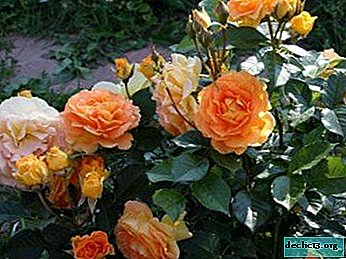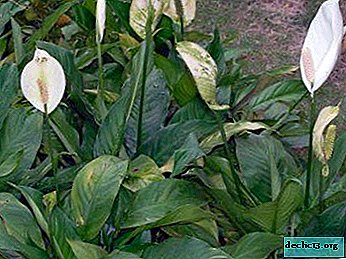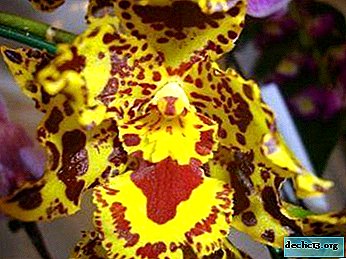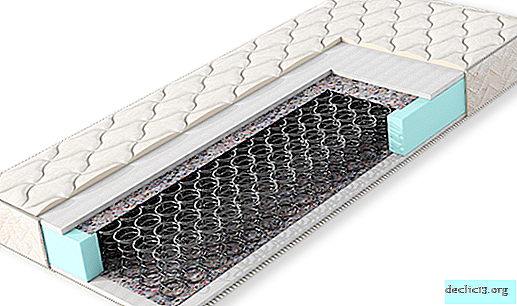Description and photos of the climbing rose Polka. Plant Care and Reproduction

The wicker rose Polka is very popular. She often decorates balconies and is used for vertical gardening, decorate arches and arbors. This plant looks good paired with curly flowers.
Further in the article we will talk in more detail about this variety and its difference from the rest of the species, we will clearly show in the photo how the flower looks. We provide step-by-step instructions for caring for this beautiful plant, as well as talk about the most common problems and pests of the climbing rose Polka.
Detailed description and photo
This variety of climbing roses can be grown in the form of a whip - klimber or a large ball. Bushes:
- powerful;
- vigorous;
- wide;
- thick.
Shoots of a climbing rose Polka:
- hard;
- dense;
- with massive spikes.
Dark green leaves of large sizes. Polka rose flowers consist of 25-35 petals, which makes them double. They can be located one at a time and with brushes.
Flowers have different shades.:
- peach;
- coral;
- apricot.
Over time, the tips of the petals fade and become creamy in color. As a result, the flowers look very original.




History of occurrence
Polka is a variety of French breeding. He was bred in 1991 in a nursery. In the same year, the variety was introduced in the United States.The polka rattan rose was obtained by crossing the 'Meipaisar' × 'Golden Showers' and the pollen of the scrub 'Lichtkonigin Lucia'. It perfectly combines the qualities of climbing roses and the magnificent shape of a flower.
What is the difference from the rest of the species?
The variety of climbing rose Polka differs from the other climbing species in its large flowers. Its stem develops rapidly, reaching a length of 2 meters. For the correct formation of the crown, the plant must be constantly trimmed. Over the summer, a flower blooms several times with large flowers. In winter, without a thorough shelter, the variety is able to tolerate a temperature of at least -29 ° C.
Bloom
Polka blossoms long and plentifully. Buds evenly replace each other. There are so many of them that the branches bend to the ground. Flowering begins in June and continues with minor interruptions until the fall. In warm habitats, there can be three waves of flowering, in cool ones - two. Flowers change shape and color depending on:
- temperature
- humidity;
- season.
If it is hot and dry, then its petals quickly crumble. The construction of a shading grid will help prevent this. Wilted flowers need to be removed.
 Spiky Polka often does not bloom due to depleted soil. The flower does not need to be planted in sandy and clay lands. Overgrowth in the root zone also prevents the plant from blooming. When a large number of shoots grow, the rose turns into a wild game, taking a lot of nutrients. Unnecessary processes must be cut off at the soil level.
Spiky Polka often does not bloom due to depleted soil. The flower does not need to be planted in sandy and clay lands. Overgrowth in the root zone also prevents the plant from blooming. When a large number of shoots grow, the rose turns into a wild game, taking a lot of nutrients. Unnecessary processes must be cut off at the soil level.
Also, the reasons that the climbing rose Polka does not bloom is:
- excess nitrogen;
- disease;
- inappropriate place.
Further on the video you can visually see how the Polka rose blooms:
Step-by-step care instructions
Before planting a polka rose you need to choose the right site, taking into account the features of the soil. It does not tolerate lowland areas in which water accumulates, destroying the roots, so the plains are best suited for it.
This variety grows well in both sunny and shaded places. However, it should be borne in mind that only upon receipt of a sufficient amount of sunlight will the plant bloom profusely. A loamy type of soil is suitable for it, which passes water well. Another land needs to be made more fertile by adding:
- phosphate fertilizers;
- humus;
- bone meal.
At the bottom of the pit, prepared for planting a climbing rose Polka, it is necessary to pour humus or manure.
Attention! Drainage for planting roses Polka can be expanded clay, fragments of brick or clay pots.The root neck of the plant should be at a depth of 12 cmwhere she will take root. At such a depth, the flower will not freeze in winter. After planting, it should be well watered - at least 1 bucket per bush. The earth must be carefully tamped so that there are no roots on the surface.
Roses are fed organic or fertilizer, which contains peat. During the growing season they need to be applied 4 times, and during flowering it is not necessary to fertilize.
 For the climbing rose Polka additional support is needed. It can be:
For the climbing rose Polka additional support is needed. It can be:
- trunk;
- old driftwood;
- wooden, metal grate.
Florists advise placing vertical supports near the wall, on which later to tie up shoots, flowers will appear on it above. If the supports are placed horizontally, then the flowers appear to the eye throughout its area.
Adult bushes of the climbing rose Polka are transplanted only if it needs urgent rescue or the place has become unsuitable for its cultivation. Work is carried out in September - early October. Then the plant will have time to take root before frost. It can be done in the spring, but before the awakening of the kidneys.
The bush is carefully dug in a circle.. Damage to the roots must not be allowed. Having dug up, they clear from the soil, cutting them and shoots. After that, they plant in a dug hole in advance. Rosa Polka should never be flooded, but drought should not be allowed. Under each bush of a transplanted flower, you need to pour warm water 3 times a week. What is needed is warm because the roots are not yet strong, therefore they react poorly to cold water.
Important! The polka-dot climbing rose needs pruning, which helps to form a lush crown, stimulate flowering, thereby increasing the decorativeness of the flower. Thanks to the correct pruning, the plant will bloom continuously throughout the growing season.These works are carried out in the spring and autumn. Before the rose begins to blossom from the bush, the frozen and obsolete shoots are removed, and the remaining ones are cut to a strong external bud. Subsequent pruning work depends on the number of flowering periods per year.
The climbing rose Polka needs preparation for wintering, which consists in stopping:
- glaze;
- loosening the soil;
- making nitrogen.
It is necessary to prepare the plant for winter in dry weather. The scourge of roses must be removed in the supports and trim the excess. Put a layer of spruce branches or dry leaves on the ground. Tie the lashes tightly with a rope and press them to the ground with hooks or arcs. Thoroughly cover the climbing rose Polka is advised only when the temperature drops to + 5 ° C. With earlier coverings, the flower may begin to sprout or sprout. From above it is necessary to cover with a box.
How to propagate?
The climbing rose is propagated by cuttings. It is he who allows you to save all its varietal qualities. Cuttings must be selected carefully, they should have a decent amount of internodes. They must be healthy.
 Before they are planted in the ground at the bottom, all the leaves are cut.
Before they are planted in the ground at the bottom, all the leaves are cut.- Then roots should grow on it. For this, the stalk is put in advance in boiled and cooled water, and the soil in which it will be planted is fertilized with humus and sand is added there.
- This process is planted in a separate pot, it is deepened into the ground by 1-1.5 cm. A pot with a handle of a climbing rose Polka should be placed in a warm place.
- Later, before planting in open ground, it is cut to a height of 20 cm. This will allow the bush to grow larger, and the rose will bloom very rich in the future.
Diseases and Pests
Polka is endowed with medium resistance to diseases such as powdery mildew and black spotting. Her most dangerous diseases are:
- gray rot;
- burn bark;
- bacterial cancer.
There is no cure for the latter, but if you are serious about prevention, you can significantly reduce the risk of it. For prevention, flower growers are advised to plant the plant in open places where air circulates perfectly, draining the leaves from moisture.
Aphids and spider mites belong to pests of the climbing rose Polka. If there are few of them, then you can try to fight folk remedies. Garden ants also harm this flower. The use of insecticides will help get rid of all pests.
The climbing rose Polka is a delightful member of the rosehip family. If you competently take care of her, then you will have the opportunity for many years to admire her beautiful large flowers and breathe in a sweet smell. Many flower growers in order to hide the lower part of the bush, which is not very rich in leaves, plants of low growth are planted nearby.
Useful video
We offer you to watch an informative video about the climbing rose Polka:

 Before they are planted in the ground at the bottom, all the leaves are cut.
Before they are planted in the ground at the bottom, all the leaves are cut.















